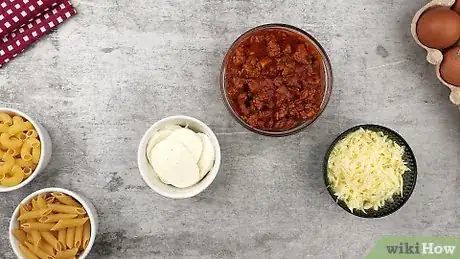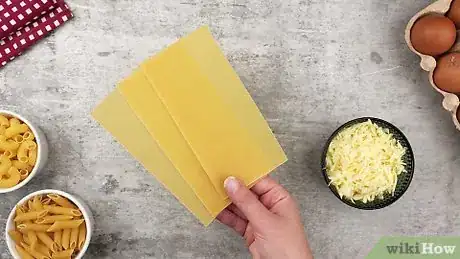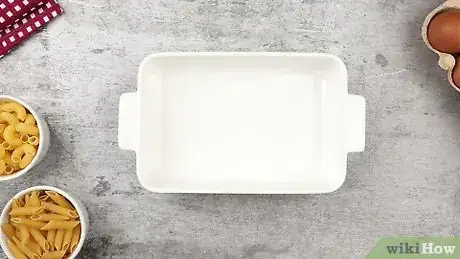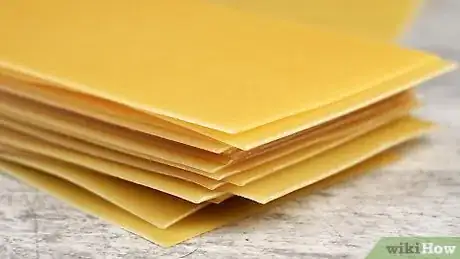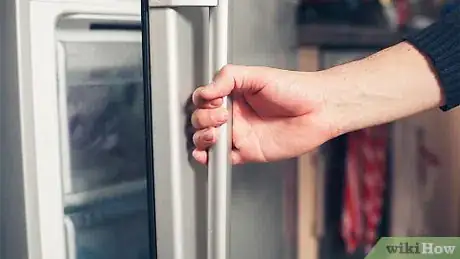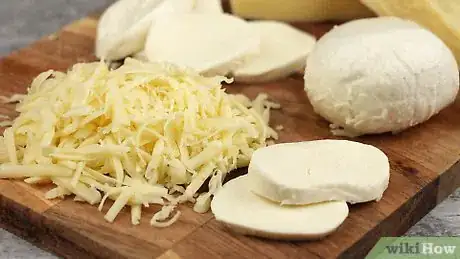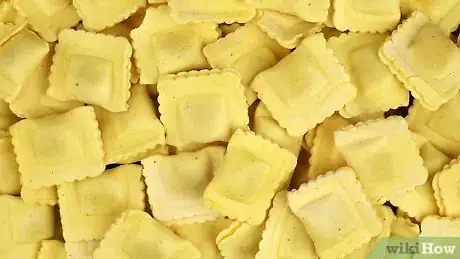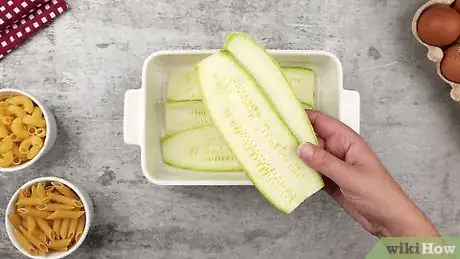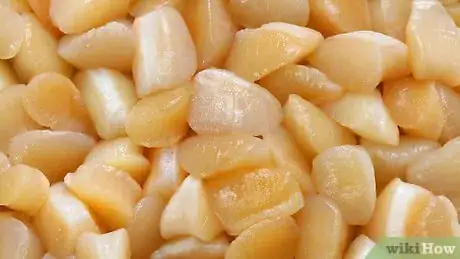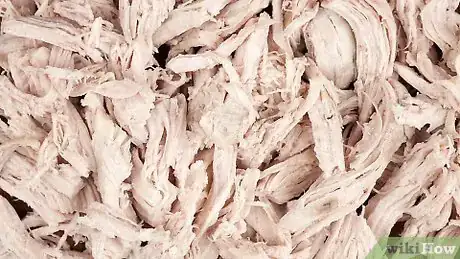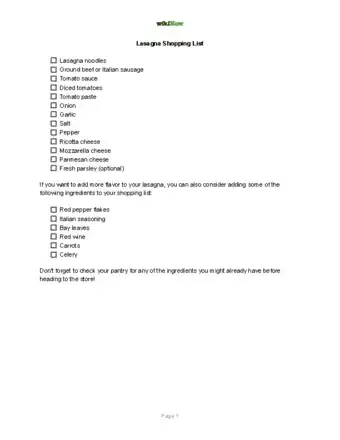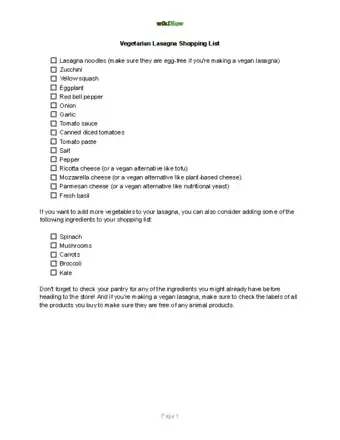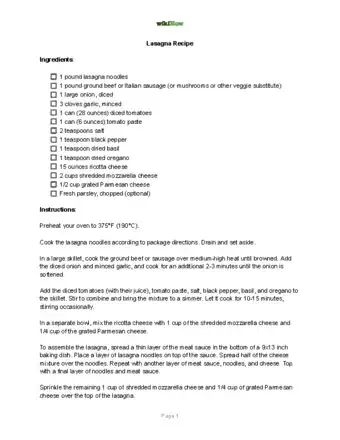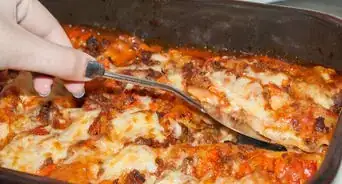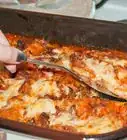This article was co-authored by Ollie George Cigliano. Ollie George Cigliano is a Private Chef, Food Educator, and Owner of Ollie George Cooks, based in Long Beach, California. With over 20 years of experience, she specializes in utilizing fresh, fun ingredients and mixing traditional and innovative cooking techniques. Ollie George holds a BA in Comparative Literature from The University of California, Berkeley, and a Nutrition and Healthy Living Certificate from eCornell University.
There are 7 references cited in this article, which can be found at the bottom of the page.
This article has been viewed 770,027 times.
Your ingredient options when making lasagna are virtually endless. You can make vegetarian lasagna, a meat lover’s lasagna, or lasagna with all the works, packed with your favorite seasoned meats, cheeses, and vegetables. Lasagna is a delicious and hearty dish great for dinner entrees. It might seem a little tricky to figure out how to get all the ingredients into your lasagna properly without it getting messy or falling apart, but don't worry. Layering your lasagna is simple and easy. Once you master the art of layering your lasagna, you can truly get as creative as you want without even following a recipe.
Steps
Preparing
-
1Get all your ingredients ready. This means any cold ingredients, like cheese, hot ingredients, like meat or grilled vegetables, and your sauces. Make sure you have a clear and clean workspace and everything is within easy reach.
- Keep things organized by separating your ingredients into individual bowls on your counter space.
- If you are making a meat lasagna, try minced beef, chicken, or pork mixed with a little bit of bacon and seasoned with herbs. Make sure your meat is fully cooked before layering it into your lasagna.
- For vegetarian lasagna, try mushrooms, sliced zucchini, and fresh spinach.
-
2Choose your noodles. You can use no-boil or regular lasagna noodles. You must precook standard, dry lasagna noodles to soften them before you layer them into your lasagna, while no-boil noodles cook during the baking process.
- Choose your noodles based on preference and how much time you have. If you don't have a lot of experience making lasagna, you can make a lasagna a lot more quickly with no-boil noodles.
Advertisement -
3Get the right kind of dish. For the layering effect of your lasagna to work, you'll need a deep, wide dish. You can use either a glass or metal dish. Pick the dish that is deepest and wide enough for the size of the lasagna you need to make.[1]
- A deep dish will require longer to cook than a shallow one.
- Glass is a poor conductor of heat, but it also distributes heat more evenly. Using a glass dish will help your lasagna cook more evenly and stay warm if you need to wait for someone to get home before serving dinner.
- Metals, especially aluminum, are generally better at conducting heat. They heat up quickly, but also can lose the heat quickly once removed from the oven. Using a metal dish may crisp the edges and bottom of your lasagna more than a glass dish would. Also, because metal dishes lose heat quickly, you won't want to wait too long before serving.[2]
Layering
-
1Get your noodles ready. If you are using no-boil noodles, remove them from the package and place them with the rest of your ingredients. If you are using regular noodles, follow package directions for cooking time, and drain thoroughly. Allow them to cool for a few minutes. They can be very hot to handle while assembling the lasagna. Running cold water over them helps this along, but be sure not to let the noodles sit too long after cooling, as they will stick together.
- If you're using a smaller pan than the recipe calls for or are only making half the recipe, you can cut the cooked noodles to fit. You can also carefully break the no-boil noodles to fit the shape of your dish.
- Tuck the ends of your noodles into the pan before baking, as any that extend over the edges may burn or dry out and become hard and brittle.
- For easier serving and a golden edge, lightly buttering your glass or metal baking dishes before assembly. If using a nonstick surface, butter may be unnecessary.
-
2Begin your first layer. Start with a small amount of sauce at the bottom of your dish to keep your lasagna moist and prevent the bottom layer of pasta from sticking to the pan.[3] Take a sheet of your boiled and strained regular noodles or no-boil noodles and lay them out flat at the base of your dish, overlapping them slightly. The goal is to get the entire bottom of the dish covered in a layer of noodles.[4]
- Remember, you can cut or break your noodles to fit the size and shape of your pan if necessary.
- If using no-boil noodles, you may want to break them to fit instead of overlapping them, as the overlapped parts can get hard while baking.
-
3Add the filling. Your filling will vary depending on the recipe. Follow your recipe guidelines to create your filling and spread it over your base layer of noodles.[5] Spread about 1/3 of your filling onto the base noodles.
- Don’t let your layers get too thick! This can cause your lasagna to fall apart when serving and eating.
-
4Drizzle on the cheese. Follow your recipe guidelines to create your cheese mixture and cover the surface area of your dish with a thin layer of cheese. Use enough cheese so you can cover the previous layer.[6]
-
5Pour on some sauce. Use a spoon to drizzle sauce over your cheese until covered. Depending on the size of your dish, you may need to use more or less sauce.
- Take care not to use too much sauce; this could create a runny lasagna.
- When using no-boil noodles, use slightly more sauce. No-boil noodles will absorb more moisture to cook.
-
6Repeat the process! Once you have laid down the second sauce layer, place another layer of noodles on top, followed by your filling, cheese, and another layer of sauce.[9] The number of layers your lasagna has will vary by recipe and size of your dish. Use your entire filling mixture.
- Make sure to leave about four noodles, or as many you would need to cover the top of your lasagna.
- Leave a little bit of extra cheese to sprinkle on top.[10]
-
7Top it off. Finish your lasagna by placing four noodles on the top, one crosswise and three lengthwise. You may need to use more or less depending on the size of your dish. Sprinkle your remaining cheese on top. This will cook to make a nice brown surface. Sprinkles of sweet paprika make a delicious final addition.
- If you are using no-boil noodles or prefer a more sauce on your lasagna, you can add a thin layer of sauce to the top.
-
8Freeze your lasagna (optional). If you'd like, you can cover your lasagna dish with aluminum foil and place it in the freezer for up to three months and still bake beautifully.[11]
- Make sure to let your frozen lasagna completely defrost before baking it, otherwise you may have to increase the cooking time.
- Remove frozen lasagna from the freezer the night before you plan to bake it and let it thaw in the refrigerator overnight. It's better to cool your lasagna slightly frozen than to let it thaw on the countertop.
Getting Creative
-
1Try some different sauces. Red sauces, with and without meat are the more popular and traditional sauces to use with lasagna, but you can also create delicious Alfredo lasagna.
-
2Mix up the cheese. For an interesting and innovative twist, swap out the ricotta for cottage cheese. You can also use slices of mozzarella instead of grated. Sprinkle in some Parmesan cheese too!
-
3Try trading your noodles for ravioli. This can create truly exciting lasagna as you can pick and use your favorite ravioli. Try a mushroom, meat, cheese, or vegetarian ravioli for a delicious twist on a classic dish.
-
4Ditch the noodles all together! This is a great way to enjoy lasagna if you are on a low carb diet or need to eat gluten free. Use slices of zucchini instead of noodles; you will be eating healthy without even realizing it.
-
5Create seafood lasagna. If you’re looking for a recipe to absolutely impress the pants off someone, try a classy seafood lasagna. Load your lasagna with crab, shrimp, and scallops.
- Red sauces can easily overpower the delicate flavors of most seafood. Make your seafood lasagna with a creamy white sauce instead.
- This recipe is very easy to assemble in advance; giving you more time to enjoy the company you are sharing it with.
- For truly special occasions, try adding lobster to the mix at the same time you add the crab.
-
6Explore the options! Make use of any leftover chicken or steak in your fridge from last night’s dinner; don't be afraid to mince it up for lasagna! If you have some tomatoes or onions that need to be used, dice them and toss them in your sauce.
- Be careful of adding additional ingredients. You may have to adjust your cooking time.
- Precooked ingredients will usually be fine, as they're just getting reheated as part of the lasagna but if you're introducing fresh ingredients, such as slices of zucchini or shredded carrot, be sure that the fresh food will cook in time.
- Chop items into small pieces if you're unsure.
Lasagna Shopping Lists and Recipe
Community Q&A
-
QuestionShould I have adult watching me?
 Community AnswerYes, especially if you are younger than 12 and are operating an oven or using sharp tools.
Community AnswerYes, especially if you are younger than 12 and are operating an oven or using sharp tools.
Warnings
- Make sure all your meat is fully cooked before adding it to your lasagna.⧼thumbs_response⧽
- Runny sauces spoil lasagna. Choose chunkier and thicker sauces over runnier, thinner ones.⧼thumbs_response⧽
Things You'll Need
- Lasagna dish
- Baking spray or olive oil
- Large pasta pot
- Towels for noodles
- Colander
- Deep sauté pan wide saucepan
- Medium bowl
- Spoon
- Knife
References
- ↑ http://www.thekitchn.com/glass-vs-metal-bakeware-is-there-a-difference-food-science-217961
- ↑ http://www.universetoday.com/82331/what-is-conduction/
- ↑ https://www.thekitchn.com/how-to-make-lasagna-home-hacks-109313
- ↑ Ollie George Cigliano. Private Chef & Food Educator. Expert Interview. 18 October 2021.
- ↑ Ollie George Cigliano. Private Chef & Food Educator. Expert Interview. 18 October 2021.
- ↑ Ollie George Cigliano. Private Chef & Food Educator. Expert Interview. 18 October 2021.
- ↑ http://www.delallo.com/recipes/classic-three-cheese-lasagna
- ↑ Ollie George Cigliano. Private Chef & Food Educator. Expert Interview. 18 October 2021.
- ↑ Ollie George Cigliano. Private Chef & Food Educator. Expert Interview. 18 October 2021.
- ↑ Ollie George Cigliano. Private Chef & Food Educator. Expert Interview. 18 October 2021.
- ↑ http://www.fromvalerieskitchen.com/2013/09/homemade-frozen-lasagna/
- ↑ http://www.delallo.com/recipes/classic-three-cheese-lasagna
- ↑ http://www.jamieoliver.com/news-and-features/features/how-to-layer-the-perfect-lasagne/#7t0Lr0oyCewUl1W2.99
About This Article
To layer lasagna, start by pouring a little bit of sauce into the baking dish, which will prevent the bottom of the lasagna from drying out. Then, cover the bottom of the dish with a layer of noodles. Next, add one-third of your lasagna filling to the dish and spread it out over the first layer of noodles. Once you've added the filling, make a thin layer of cheese over it. Then, add some more sauce and repeat the process until you've added all of your filling. Top the lasagna off with a layer of noodles and a little bit of cheese on top. If you want to learn more, like what kinds of sauce to use inside your lasagna, keep reading the article!
